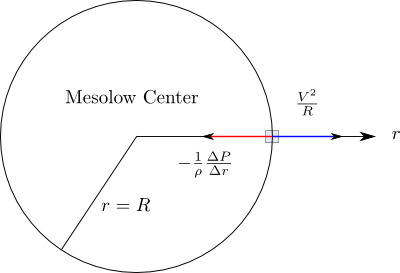The mesolow forms as the rotating air parcels are pulled outward from the center by the outward-pointing centrifugal force. In response, the inward pointing pressure gradient force increases until its magnitude is equal to that of the centrifugal force.
The outward direction is taken as positive in the polar coordinate system. The radial forces are in balance because the radius of the parcel's path is constant ($r = R$). Therefore,
$\frac{1}{\rho}\frac{\Delta P}{\Delta r} = \frac{V^2}{R}$
The equation above is known as the "cyclostrophic equation," and the radial forces on the parcel are said to be in "cyclostrophic balance." The angular speed of the parcel is denoted by $V$. The parcel's angular direction of motion can be either clockwise or counter-clockwise depending on the environmental circumstances that initiates the circular motion.
Figure 1. The mesolow and significant radial forces.
